Synopsis
Whoah. MGM if really digging into the vaults to bring us these. Xaviera Hollander is not much more than the answer to a trivia question today, but for a while in the 70s, she had enough profile to warrant three films based first on her book, then more generally on her persona. Lynn Redgrave (!) plays her in The Happy Hooker (1975), which follows her arrival in the States and cheerful discovery of the life she was born, it seems, to lead. Mysteriously rated R, this is a film that could…have played without cuts on prime time TV twenty years ago. A film all about sex with no sex in it. Makes you long for Joe D’Amato and Laura Gemser to arrive and save the day.
Joey Heatherton takes over the role for The Happy Hooker Goes to Washington (1977), a film that no longer pretends to be a biography. It does pretend to be funny, but its tale of Xaviera getting involved with a Washington sex scandal and Congressional hearings is utterly tedious. And oh look, here’s George Hamilton co-starring. Talk about a falling star.
The comedy is even broader for The Happy Hooker Goes Hollywood (1980), wherein Martine Beswicke (of many a Hammer film) takes the lead in a story about Xaviera’s book being made (badly) into a film. Yikes! Too postmodern for me. Each film became more nudity-filled than the last, and this is something of a sad apotheosis in that respect, and also features the likes of Adam West and Phil Silvers in major roles. So, as you can guess, underacting breaks out on all fronts. Sarcasm. This one, at least, has some interest for the on-screen talent debasing itself.
Audio
Mono and stereo options are available in all three cases, and as is too often the case, the stereo mix has utterly indiscriminate surround characteristics. This is most apparent in the case of the first film, where the rear speakers are almost louder than the front. Sibilance is more of a problem with the second film. Still, if you can bring yourself to watch the movies all the way through, the sound won’t be a major problem.
Video
The films tend to start with rough, dirty, grainy credit sequences, and then the picture improves. The colours are nice, and the images are decently sharp. Grain after the opening is minimal, and the contrasts are very good. All three films are in their original 1.85:1 widescreen ratios, but the first one is not anamorphic.
Special Features
None.
Closing Thoughts
For my money, the Black Emanuelle films are a lot more interesting than this flaccid lot. There’s a certain curiosity value here, but not much else.






